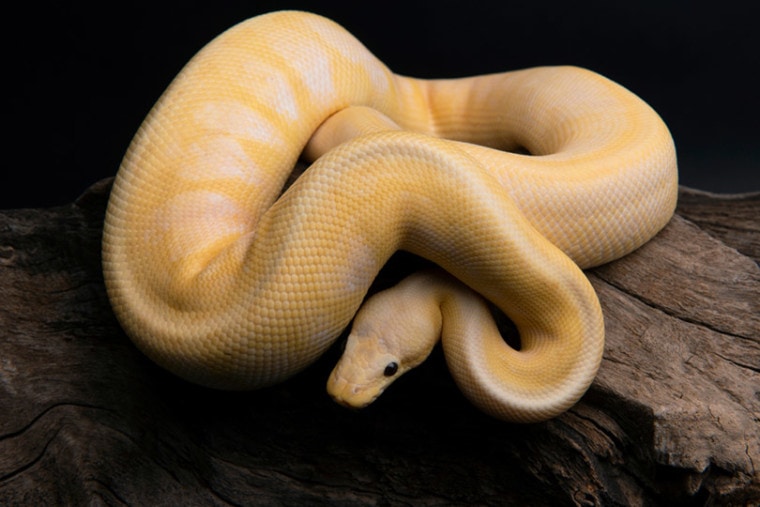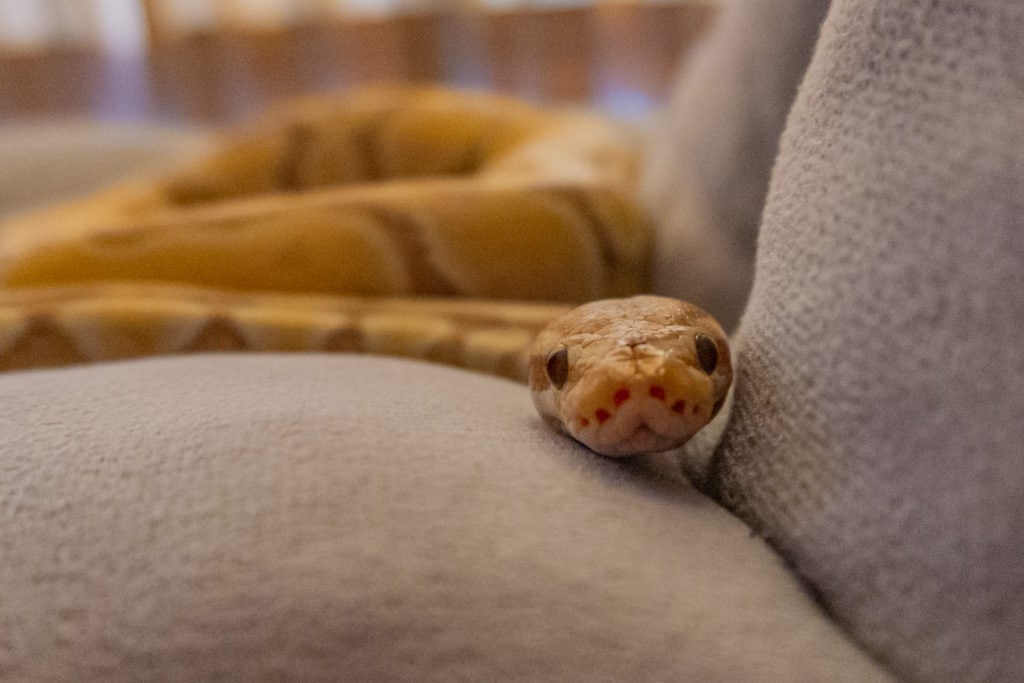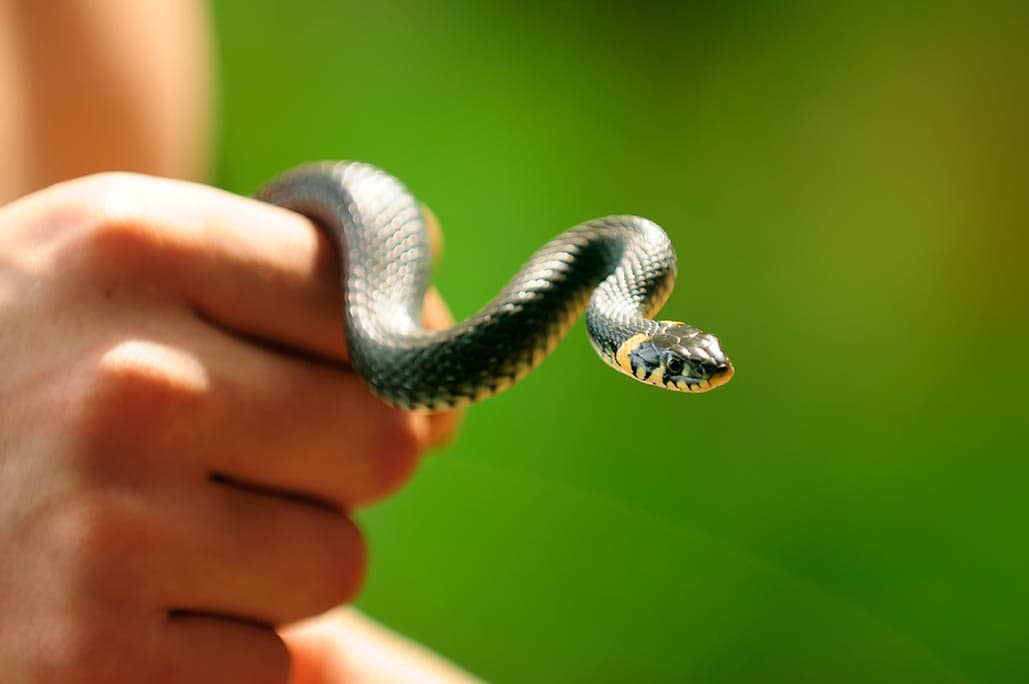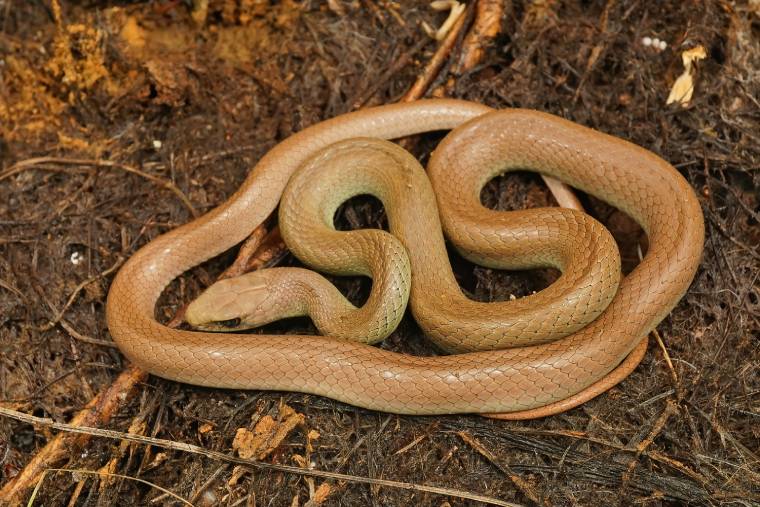
The Banana Ball Python is a unique morph famed for their intense yellow coloration with blotches of light and dark yellows. The species has yellow and tan patterning, making them similar to the coloration of a banana, hence their common name.
If you have been looking for a low-maintenance pet snake that has a friendly nature, the Banana Ball Python morph is an excellent option. Are you looking for more information before you invest in one of these Pythons? Then, you have come to the right place.
Quick Facts About Banana Ball Python Morph

| Species Name: | Python regius |
| Common Name: | Ball Python |
| Care Level: | Medium |
| Lifespan: | 20 – 30 years |
| Adult Size: | 2 – 5 feet; 1,000 – 1,750 grams |
| Diet: | Only rodents |
| Minimum Tank Size: | 60 gallons |
| Temperature & Humidity: | 50 – 60% humidity and 75 – 85 degrees Fahrenheit |
Do Banana Ball Python Morphs Make Good Pets?
The Banana Ball Python morph makes an excellent pet for those who want a docile reptile. The Ball Python is known for their friendly nature and tolerance for being handled. It might take time to adapt to their new environment, but they can become lovable pets.
The Banana Ball Morph is often produced by breeders, although they can originate naturally in the wild. However, this is rare. Will Slough was the first to breed the Banana Ball morph.
Initially, these snakes were sold for more than $20,000, but since then, more than 20 different types of banana morphs have developed due to their unique coloration and friendly nature.
Some of these include the banana pied, banana clown, banana cinnamon, banana spider, and the black pastel banana.

Appearance
The Banana Ball Python morph was first developed in 2003. They are one of many varieties of these mottled yellow snakes. The Banana Ball Python is a co-dominant morph, meaning you only need one of these Banana Pythons to create Banana Ball Python babies.
An incomplete dominant genetic mutation causes the coloration of these snakes. They aren’t only characterized by their coloration, though. They have stocky bodies and small heads typical of most Ball Pythons. They also have very smooth scales.
The Banana morph can mix with other co-dominant or dominant snake morphologies. The more dominant pairings will not always result in Banana Ball Python morphs. However, if you pair two Banana Ball Python snakes, you will often produce Python morphs called Super Bananas.
How to Take Care of Banana Ball Python Morph
Before you get one of these snakes or any other reptile, for that matter, you need to make sure you have their habitat set up. Their enclosure is one of the most critical parts of their life because they can’t move and find a new climate by themselves.

Tank
You should have the tank of the Banana Ball Python Morph set up and ready for them before they arrive at your home. These snakes need a tank of at least 60 gallons. They need plenty of places inside the tank to hide and move around in and a basking rock close to their source of heat.
During the daylight hours, these snakes will want to burrow. You could supply burrowing opportunities by adding logs or other hiding places throughout the tank.
You should also supply your Banana Ball Python with an area filled with water so they can soak. This space will be especially important during the times that they are molting because they will use the water to loosen their scales and make that transition more comfortable.
You can use a large water dish to create this space. You won’t have to worry too much about them drowning because Pythons are known as good swimmers.
However, you should make sure the dish has multiple entry and exit points. That means it shouldn’t be crowded with other tank paraphernalia so the snake can easily exit when they want to do so.
Lighting

Pythons live in areas that tend to be quite close to the equator. When you try to mimic their natural space, you will want to keep the light and dark times about even. The snake needs their tank to have about 12 hours of light each day and then 12 hours of darkness.
When you turn off the light in their cage, it naturally cues them to become more active. This time is typically when they will hunt.
Heating (Temperature & Humidity)
A snake needs a well-controlled climate inside their tank. You should carefully monitor the temperature and humidity in their tank because too much of a dip or change can negatively impact their health for a long time.
The Banana Ball Python needs their tank to have a humidity level between 55% and 60%. Keeping the bowl of water in their hot tank should help because it will regularly evaporate. You can also maintain the humidity by misting the tank daily.
The heat of the tank should be maintained between 80 degrees and 85 degrees Fahrenheit. Their basking spot should rest between 86 degrees and 90 degrees Fahrenheit. At night, the temperature of the tank should be slightly less, resting between 72 degrees and 79 degrees Fahrenheit.
You can use a 75W infrared bulb in a heat lamp to get the tank to the right temperature. Before you put your snake in the tank, though, test the light and heating for a couple of days to make sure you place it in the right proximity to the tank for the ideal temperature.

Substrate
The substrate is the final influential part of a Python’s tank setup. The best substrates for a Python that mimic their natural environment include soil, sand, and wood shavings. You can also mix these to give them a variety.
You need to ensure that their substrate gets cleaned regularly. Not keeping the tank clean will almost assuredly negatively impact your snake’s health. Replace the substrate, and clean the rest of the tank out by using a cloth and water.
|
Tank Recommendations |
|
| Tank Type | 60-gallon glass or plastic tank |
| Lighting | 12 hours of light and dark |
| Heating | 75W infrared heat lamp |
| Best Substrate | Sand, soil, or wood shavings |
Feeding Your Banana Ball Python Morph
The Banana Ball Python is a true carnivore. You can only feed Banana Ball Pythons different kinds of rodents when they are in captivity. When you feed them, you should make sure the rodent isn’t any wider than the broadest part of your snake’s body.
You can feed your Python live mice or frozen mice. However, it is a good idea to warm frozen food up to at least room temperature first. This is because Pythons hunt using thermal radiation. If the prey is too cold, they won’t be able to find it.
Related reads:
| Diet Summary | |
| Fruits | 0% of diet |
| Insects | 0% of diet |
| Meat | 100% of diet: small/medium-sized rodents |
| Supplements Required | Calcium |
Keeping Your Banana Ball Python Morph Healthy
The Banana Ball Python is quite a healthy snake. They rarely get sick unless they are older. Many of their sicknesses come from husbandry issues, but others come from the poor management of the snake’s enclosure.

Common Health Issues
Respiratory infections in snakes are typically caused by improper humidity levels or a cage that isn’t cleaned well. You can recognize the symptoms associated with respiratory disease when you hear wheezing sounds, see mucus coming from their nose or mouth, or detect open mouth breathing.
Weight management can be complex with these snakes. Anorexia is common.
But as long as you manage their enclosure well and feed them so their weight is maintained, you should be able to keep them healthy for many years.
Lifespan
The Banana Ball Python has a lifespan in captivity between 20 and 30 years. Their lifespan is quite long for a snake. Therefore, you need to understand that they are a long-term commitment. These snakes will need care for many years and shouldn’t be a passing fancy for their owner.

Breeding
Banana Ball Pythons, like other snakes, are born from eggs. These are around 3 inches wide and weigh between 70 to 100 grams. Interestingly, these will all adhere to each other until they are within 4 days of hatching.
The best temperature that a female will brood eggs in is between 86 degrees to 88 degrees Fahrenheit. The humidity needs to be at the high end of the scale.
These snakes breed annually. You should only keep them in the same enclosure when they are ready to breed since Pythons are solitary creatures. When they breed, they produce clutches that produce between one to 11 offspring.
Mating is only cued with specific environmental changes, so it is a challenge for Ball Pythons. You can cue them by using fasting and dropping the temperature.
Are Banana Ball Python Morphs Friendly? Our Handling Advice
Banana Ball Pythons are friendly. However, they easily get spooked by sudden movements. That is why you need to be careful when you reach their cage or get close to them. Approach them slowly and steadily in front of them to make sure they see you.
Be aware that these Pythons get stressed if they are handled too much. Work with them steadily, and they will become used to being handled and can even come to enjoy the bonding experience.

Shedding & Brumation: What to Expect
A healthy Banana Ball Python morph will shed their scales every 4–6 weeks. During the time that they shed their scales, you will notice that their scales become loose.
Their eyes also start to become quite milky or opaque. During this time, you should be careful when handling them because they can’t see well.
Ball Pythons don’t brumate like many other reptile species. Instead, they might simply reduce their feeding during the winter season and sleep more often. You won’t have to do much about this; just remove any dead mice or parts 2 days after you put them in the tank.
How Much Do Banana Ball Python Morphs Cost?
The Banana Ball Python morphs cost between $100 to $150 for a baby or newborn hatchling. Since they are easy to breed genetically, they are a more cost-effective option.
Adult Banana Ball Pythons cost between $200 to $300. The most expensive of the morphs, often the Scaleless Banana Pythons, can cost $3,000. These are rare, though.
Care Guide Summary
- You may also want to read: Pastel Ball Python Morph
Conclusion
The Banana Ball Python morph is one of the more common Python morphs available. That means they are easier to find and more affordable. If you have been wanting to give owning a pet snake a try, this is a good option for beginners.
Just because these snakes are beautiful and somewhat easy to come by, though, that doesn’t mean that the commitment of keeping them as a pet should be taken lightly. Remember that they have long lifespans. When you adopt one of these snakes, you are taking on the long-term responsibility for their health and wellbeing.
Featured Image Credit: photos2013, Shutterstock









